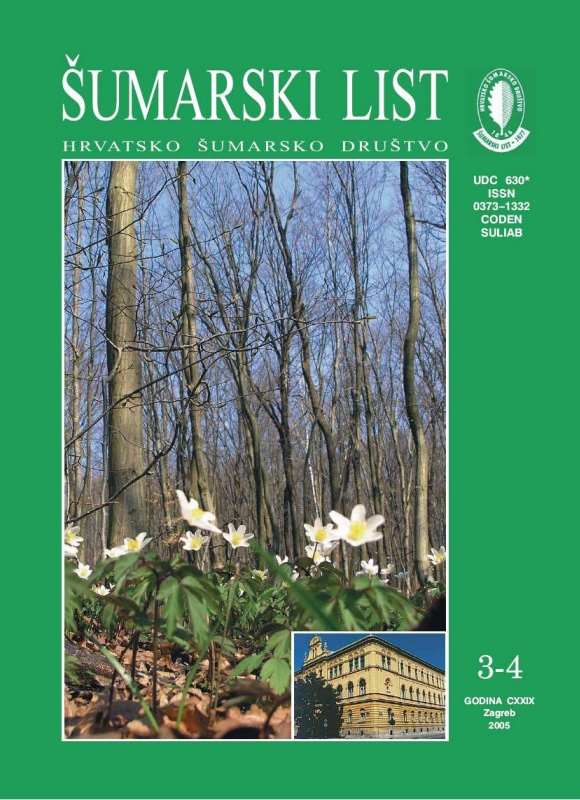
broj: 3-4/2005
pdf (26,0 MB) |
|
||||||||||||||
| IZVORNI ZNANSTVENI ČLANCI | ||
| Trinajstić, I., Z. Cerovečki | UDK 630* 188 (001) | |
| Contribution to the Syntaxonomic Analysis of the Ass. Erico-Fagetum (Ht. 1962) Trinajstić 1972 pdf HR EN | 135 | |
| Summary: In the work new data on the phytosociological and syntaxonomical characteristics of the ass. Erico-Fagetum (Ht. 1962) Trinajstić (1972) from some parts of Gorski Kotar and Lička Plješevica in Croatia are given. The ass. Erico-Fagetum can be considered as a moderately thermophilous, edaphically conditioned beech forest growing on the dolomite on somewhat higher inclinations of steep slopes exposed to sun from 600 to 940 m above sea level. In addition to continuous anthropic impacts, the lithologic and orographic conditions are main factors preventing a progressive development of forest vegetation and, therefore, the ass. Erico-Fagetum generally is found as the permanent stage. The ass. Erico-Fagetum floristic composition, shown in Table 1, besides the typical fagetal elements contains also many thermophilous species significant for pine forests of the order Erico-Pinetalia (e.g. Erica carnea, Amelanchier ovalis, Helleborus niger, Epipactis atrorubens), as well as the species characteristic for the order Quercetalia pubescentis (e.g. Ostrya carpinifolia, Fraxinus ornus, Acer obtusatum, Sorbus aria, Sesleria autumnalis, etc.). Worth of noting in the association floristic composition are the species Acer obtusatum and Sesleria autumnalis, which in addition to characterizing the subass. aceretosum obtusati subass. nova., connect syndinamically the ass. Erico-Fagetum with the associations Aceri obtusati-Fagetum on one side and Seslerio autumnalis-Fagetum on the other side. A further research in that direction will be able to document with the field data. The abundant presence of the species Erica carnea suggests a considerable floristic relationship of the ass. Erico-Fagetum with the ass. Erico-Ostryetum and ass. Genisto januensis-Pinetum, their connection in addition to such floristic relationship being manifested also by progressive and regressive successions. On this occasion, syntaxonomical revision of the views supported earlier by Horvat et al. (1974) and recently by Willner (2002) has been made. In fact, after the insufficient description and wrong synsystematical classification of the ass. Erico-Fagetum by Horvat (1962), Trinajstić (1972), at the end of a critical synsystematical analysis, subordinated these forests to the group of the Illyrian beech forests of the alliance Fagion illyricum (= Aremonio-Fagion). Although this association is not mentioned by Horvat et. al. (1974) in the presentation of the vegetation of Southeastern Europe, from the floristic composition presented in the syntetic Table no. 102, columm 12, it can be concluded that the ass. Erico-Fagetum is subordinated to the association Erico-Ostryetum, and Willner (2002) in his presetation of “the syntaxonomical revision of the South and Central European beech forests” subordinates ass. Erico-Fagetum to the association Ostryo-Fagetum, while the Dinaric-Illyrian complex of beech forests of the alliance Aremonio-Fagion (= Fagion illyricum) is subordinated by him to, Central European complex of beech forests of the alliance Asperulo-Fagion, that in our opinion (cf. Trinajstić 2004) is a typical Central European view. Syntaxonomically, the ass. Erico-Fagetum, as well as all known thermophilous beech forests of Croatia, is subordinated to the suballiance Ostryo-Fagenion, the alliance Aremonio-Fagion, the order Fagetalia sylvaticae and the class Querco-Fagetea. | ||
| PRETHODNO PRIOPĆENJE | ||
| Vrbek, B. | UDK 630* 114.2 + 425 | |
| Salinisation Influence on Vegetation and Forest Soils of Island Korčula pdf HR EN | 143 | |
| PREGLEDNI ČLANCI | ||
| Štilinović, L. | UDK 630* 628.19 + 614.7 | |
| Contamination of the Sava and Drava Rivers – Causes and Health Consequences pdf HR EN | 151 | |
| STRUČNI ČLANCI | ||
| Zelić, J., M. Stojić | ||
| The Depedence of Stockwood Density an Natural Drying Period for European Ash and Common Oak pdf HR EN | 157 | |
| Puljak, S. | UDK 630* 831 | |
| Investigating the Combustible Propety of Noncommercial Tree Species for Generating Heat and Electrical Energy pdf HR EN | 169 | |
| Tolić, I. | UDK 630* 156 | |
| Barbary Sheep (Ammotragus lervia) Morphological, Biological and Ecological Properties pdf HR EN | 177 | |


